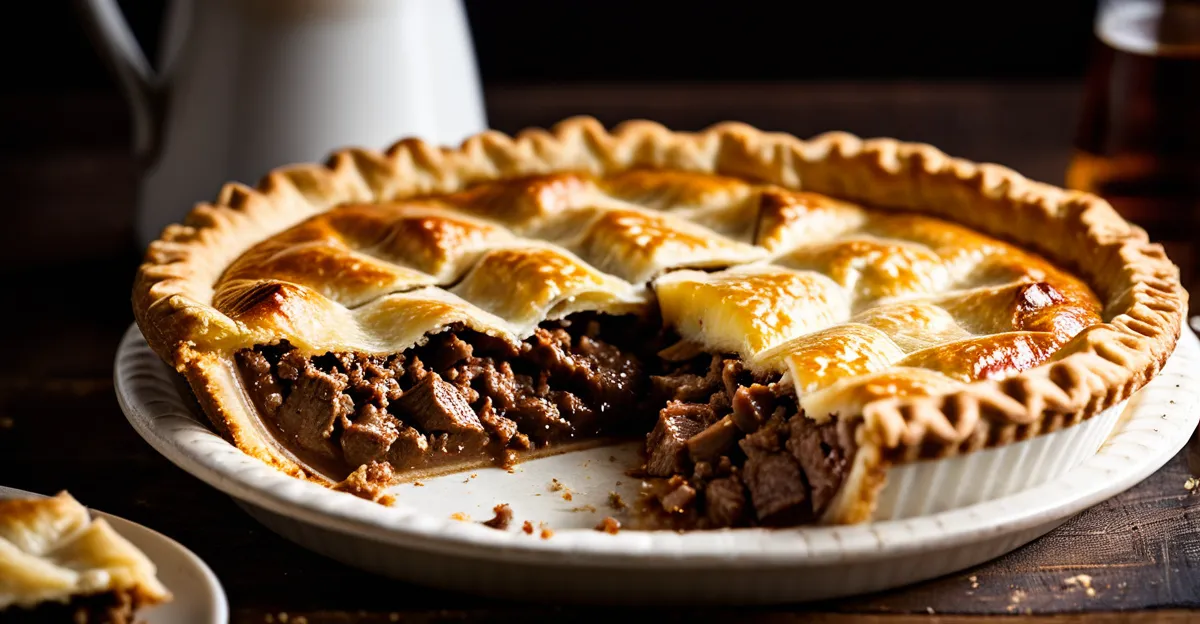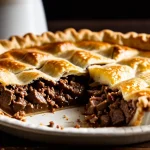Essential Ingredients for a Flaky Beef and Ale Pie Crust
Creating a flaky beef and ale pie crust begins with carefully selecting the best fats for pie crust. Butter is prized for its rich flavor and water content, which promotes steam and helps develop flakiness. However, incorporating lard or shortening can enhance tenderness and increase the number of visible layers due to their higher melting points. Many expert bakers opt for a combination—such as half butter and half lard—to balance flavor and texture optimally.
Choosing the right pastry flour choices is equally crucial. Pastry flour strikes the perfect balance between protein content and softness, providing enough gluten development for structure without sacrificing tenderness. Using all-purpose flour can result in a tougher crust, while cake flour may lack sufficient structure. Mixing pastry flour with a small proportion of all-purpose flour can also yield positive results based on texture preferences.
Also read : What are the best ways to cook a tender and flavorful bangers and mash?
Another essential ingredient factor is the temperature of all components. It is vital to use chilled ingredients, including cold butter or fat cut into small pieces and ice-cold water. This cold temperature prevents fats from melting prematurely, enabling them to create distinct layers that bake into flaky pockets. Keeping ingredients cold also slows gluten formation, which contributes to a tender crust rather than a dense one.
By focusing on these essential ingredients—selecting the right blend of fats, using suitable pastry flour choices, and incorporating chilled elements—you set a solid foundation for producing a truly flaky beef and ale pie crust that stands up well to hearty fillings.
In parallel : How can you make a classic trifle with a modern twist?
Techniques to Achieve Flakiness in Pie Crust
When aiming for a flaky beef and ale pie crust, mastering specific pie crust preparation tips is essential. The key lies in promoting distinct layers within the dough, which translate into the flaky texture once baked.
Minimal handling of dough is critical. Overworking activates gluten excessively, resulting in toughness rather than flakiness. Mix ingredients just until they combine, leaving visible flecks of fat throughout. These fat pockets melt during baking, creating the separated layers that define flakiness.
Proper layering and rolling techniques further enhance this effect. Rolling the dough gently and folding it over itself—similar to creating laminations—encourages the development of flaky layers. Each fold traps fat and air, which expands in the oven. This is why frequent, light folds with chilled dough are preferred over aggressive kneading or heavy rolling.
Consistent texture demands preventing overworking at every step. Avoid squeezing the dough or warming it excessively with your hands. Instead, treat it delicately, turning and folding just enough to hold ingredients together. This careful approach ensures the best chance of achieving that sought-after flaky texture in your pie crust.
Chilling and Resting: Key Steps for Success
Proper dough chilling is fundamental when crafting a flaky beef and ale pie crust. Chilling the dough after mixing and before rolling solidifies the fat particles, keeping them distinct rather than blending completely into the flour. This separation is what produces layer formation during baking, essential for a flaky texture. Ideally, refrigerate the dough wrapped tightly for at least 30 minutes; longer chilling strengthens results by allowing fats to firm up and gluten strands to relax.
The pastry rest time also plays a critical role in texture. Resting reduces gluten tension created during mixing, making the dough more pliable and less prone to shrinking when baked. Without sufficient rest, the crust can become tough or unevenly shaped. Typically, a rest period of 30 minutes to an hour at cool temperatures optimizes dough elasticity and handling.
Controlling temperature throughout all steps prevents premature fat melting, ensuring the crust remains flaky rather than greasy or dense. Keep the dough chilled right up until rolling, then minimize hand contact to avoid warming it. This careful temperature management enhances layer formation and helps prevent soggy crust issues commonly faced in moist, ale-filled pies. Proper chilling and resting are thus indispensable for a consistent, flaky beef and ale pie crust that withstands hearty fillings without compromising texture.
Baking Strategies for a Flaky Beef and Ale Pie Crust
Achieving a flaky beef and ale pie crust involves deliberate pie baking tips that ensure the crust bakes evenly and crisply while supporting the hearty filling. One effective method is blind baking, or pre-baking the crust before adding the filling. This step helps prevent a soggy bottom by setting the dough structure early, especially important in moisture-rich beef and ale pies.
Oven temperature greatly influences the crust’s flakiness. Starting at a higher temperature, around 200°C (400°F), initiates rapid steam generation from the fat pockets, which creates those prized flaky layers. After 10–15 minutes, reducing the heat to about 180°C (350°F) ensures the crust cooks through without burning, balancing crispness and tender layers.
Visual cues guide the ideal crust doneness. Look for a uniform golden-brown color with slightly darker spots where fats have caramelized. The edges should be firm but not overly dark. Timing usually ranges from 30 to 45 minutes, depending on pie size and oven characteristics. Monitoring these factors optimizes flakiness while maintaining structure to support the savory filling without collapse or sogginess.
Expert Tips and Common Mistakes to Avoid
Mastering a flaky beef and ale pie crust becomes far easier by applying key pastry chef secrets that professionals swear by. One vital piece of flaky pie advice is to maintain dough temperature consistently cold throughout preparation. This preserves the integrity of fats, which directly impacts flakiness and prevents greasy or dense results.
Among the most frequent pie crust troubleshooting issues are soggy bottoms and overworked dough. To avoid these pitfalls, resist the urge to overfill your pie; excess moisture from filling can seep into the crust, undermining its structure. Properly blind baking the base can significantly reduce sogginess—a crucial pie baking tip for beef and ale pies.
Underbaking is another common mistake, leaving the crust doughy rather than crisp. Monitoring visual cues such as a rich golden color and firm edges are essential to judge doneness accurately. Applying an egg wash before baking adds a beautiful sheen and encourages even browning, enhancing the crust’s appeal and texture.
In summary, these pastry chef secrets—temperature control, cautious filling, blind baking, attentive baking times, and finishing touches—equip home bakers to troubleshoot effectively and consistently produce a perfectly flaky beef and ale pie crust.






